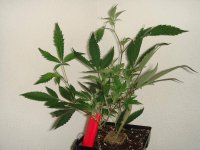SupraSPL
Member
Lots of info has been posted here and on RIU which convinced me to give these ferts a try. Due to very limted space and other restrictions I cannot compost or even mix large batches of soil so I have had to rely on liquid ferts, reused soil and all without earth worm castings to help out. Eventually the soil got depleted and I was seeing multiple deficiencies including calmag due to R/O water.
So for the apartment growing style or micro grows liquid organic ferts can get the job done very well.
The BMO ferts are guano/molasses/azomite based. I am not sure if the flavors will be better than blood/bone/kelp mixes but from what Sub says there are differences in taste from one fert mix to another. Guanos are supposed to give an excellent flavor so I was willing to pay a few extra bucks to find out. BMO is not expensive but you may go through it somewhat fast.
Another nice thing is that each batch is labeled with the date it was brewed and this information is made available to the buyer before they purchase it.
Their fert line is very straight forward:
Veg 5-2-5
Flower 1-8-7
Microbes/Micronutes/aminos 1-.5-1
The microbe tonic is interesting. It saves me from dealing with EWC and along with Epsoma plant tone is very helpful for recycling soil.
Ingredients:
Artesian Spring Water, Worm Castings, Mycorrhizal Fungi, Azomite, Unsulphured (Blackstrap) Molasses, Endo and Ecto Bacteria, and Humic Acid derived from Oak Leaf & Peat Compost.
Anyway this stuff has been working very well the plants seem to love it. New growth is shiny and lush, growth is very fast and tips are perfect no burn.
So for the apartment growing style or micro grows liquid organic ferts can get the job done very well.
The BMO ferts are guano/molasses/azomite based. I am not sure if the flavors will be better than blood/bone/kelp mixes but from what Sub says there are differences in taste from one fert mix to another. Guanos are supposed to give an excellent flavor so I was willing to pay a few extra bucks to find out. BMO is not expensive but you may go through it somewhat fast.
Another nice thing is that each batch is labeled with the date it was brewed and this information is made available to the buyer before they purchase it.
Their fert line is very straight forward:
Veg 5-2-5
Flower 1-8-7
Microbes/Micronutes/aminos 1-.5-1
The microbe tonic is interesting. It saves me from dealing with EWC and along with Epsoma plant tone is very helpful for recycling soil.
Ingredients:
Artesian Spring Water, Worm Castings, Mycorrhizal Fungi, Azomite, Unsulphured (Blackstrap) Molasses, Endo and Ecto Bacteria, and Humic Acid derived from Oak Leaf & Peat Compost.
Anyway this stuff has been working very well the plants seem to love it. New growth is shiny and lush, growth is very fast and tips are perfect no burn.



